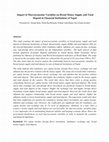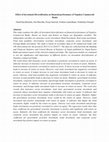Papers by Poshan Lamichhane

This study examines the impact of macroeconomic variables on broad money supply and total deposit... more This study examines the impact of macroeconomic variables on broad money supply and total deposit in financial institutions of Nepal. Broad money supply (BMS) and total deposit (TD) are the selected dependent variables while remittance inflow, inflation, per capita income, exchange rate, and foreign direct investment are the independent variables. The main sources of data include Quarterly Economic Bulletin published by Nepal Rastra Bank; Economic Survey published by Ministry of Finance and World Development Indicators of World Bank. The study is based on the secondary data which are collected for the period of 28 years from 1990 to 2017. The time series data are used to analyze the relationship between macroeconomic variables on broad money supply and total deposit in case of financial institutions of Nepal. The study indicate that remittance, per capita income, foreign direct invest, exchange rate and inflation has the positive relation with the money supply. The study also revealed that remittance, per capita income, foreign direct invest, exchange rate and inflation has the positive relation with total deposit. This indicates that higher the remittance higher would be the money supply and total deposit in the country. The result also shows that there exists a strong positive relationship between per capita income with broad money supply and total deposit. The result shows that exchange rate and foreign direct investment are positively related to broad money supply and total deposit of the country. Higher the exchange rate and higher foreign direct investment results higher broad money supply and total deposit. However the result shows that inflation has negative relationship with broad money supply and total deposit. Higher the inflation results to lower broad money supply and total deposit. The regression results also show that beta coefficients are positive for remittance, foreign direct investment, per capita income, inflation and exchange rate. However, the coefficients are significant only for remittance, per capita income and exchange rate at 1% level of significance. Similarly at a time when a country's money supply and total deposit are not favorable, the macroeconomic variables plays a very important role in maintaining financial stability and keeping economy afloat. Hence the government should focus on such macroeconomic variables in order to maintain the economic and financial diplomacy.

This study examines the effect of investment diversification on financial performance of Nepalese... more This study examines the effect of investment diversification on financial performance of Nepalese Commercial Banks. Return on Assets and Return on Equity are dependent variables. The independent variables are insurance sector investment, Bond Investment, Real estate investment, Total loan portfolio, Government securities investment, corporate sector investment, and Foreign Banks investment. The study is based on secondary data of 20 commercial banks with 100 observations for the period of 2011/12 to 2016/17. The data are collected from the Banking and Financial Statistics and Central Bureau of Statistics of Nepal published by Nepal Rastra Bank and annual reports of the selected commercial banks. The regression models are estimated to test the significance and importance of different factors on investment diversification of Nepalese commercial banks. The result shows that insurance sector investment is positively correlated to return on assets. It indicates increase in insurance sector investment leads to increase in return on assets. Similarly, bond investment is positively correlated to return on assets. It shows increase in bond investment leads to increase in return on assets. However, real estate investment has negatively correlated to return on assets. It tempts increase in real estate investment leads to decrease in return on assets. Likewise, total loan portfolio has negatively correlated to return on assets. It indicates increase in loan portfolio leads to decrease in return on assets. Similarly, government securities investment, corporate sector investment, and foreign banks investment is positively correlated to return on assets. It indicates increase in government securities investment, corporate sector investment, and foreign banks investment leads to increase in return on assets. The result also reveals that insurance sector investments, total loan, government security investment and corporate shares investment have negative relationship with return on equity. It indicates that increase in insurance sector investments leads to decrease in return on equity. Similarly, higher the government securities investment, lower would be the return on equity. However, bond investment has positive relationship with return on equity. It indicates that higher the bond investment, higher would be the return on equity. Likewise real estate investment and foreign banks investments are positively correlated to return on equity. The regression results show that beta coefficient for government securities investment is positive and significant with return on assets. Similarly, the beta coefficient for insurance sector investment, bond investment, and corporate sector investment has positive impact on return on assets. Likewise, the beta coefficient for government securities investment, bond investment, and corporate sector investment has positive impact on return on equity. Key Words: Insurance sector investment, bond investment, real estate investment, total loan portfolio, government securities investment, corporate sector investment, foreign banks investment Introduction A financial system is of vital in nature for the economic development as it provides relieve in funds mobilization. Today's volatile economic environment requires efficient financial system for specialization in production, to retain investors 'friendly relationship and competitive market as well as to assist economic transactions. A stable and efficient financial system represents efficient allocation of resources and the basic foundation for rising of financial performance of an organization which leads to enhance actions and functions of the organization. Investment provides backup to all capital market in the economy through trading in shares, investment holdings and merchant banking activities (Tarawneth, 2006). Better performance of the banks is ensured if they make lucrative, qualitative and diversified portfolio while using its loan able funds. It is wiser and safer to put eggs in different basket than putting them in one basket. The portfolio theory of Markowitz (1952) pointed out that diversification can decrease risk when individual assets are not fully correlated. Diversification is the idea that investors allocate money to different types of investment. The global financial crisis of 2008, also known as subprime crisis, was partly due to too many exposures to real estate industry. The credit portfolio concentration fatal hit the whole banking industry of United States heavily which later caused contagion effect in most of the countries. Hence, in light of this global financial crisis, the diversification of investment has become one of the important issues to discuss about bank's stability and profitability. Diversification improves cost efficiency through lower risk from it, if it occurs, and lowers the required risk premiums on un-insured debt and other contingent claims, such as derivative contracts (Moon, 1996). In banking, diversification is done functionally by combining into what is called a conglomerate such activities as commercial banking, securities trading, insurance and other financial services (Baele et al., 2007). Banking operation in competitive environment is more stable as they diversify their portfolio that results in to enhanced performance and risk adjusted returns for bank (Amidu, 2013). Wall et al. (1993) stated that banks been able to diversify into small amounts of insurance, mutual fund, securities brokerage, or real estate activities, they could have experienced higher returns and lower risk. Raei et al. (2016) argued that there is a significant relationship between loan portfolio diversification and risk among the banks listed in Tehran stock exchange. However there is no statistically significant relationship between use of portfolio diversification strategy in bank's ROA and ROE. Agostino and Claudio (2004) revealed a purpose of diversification is to collect revenue from a combination of tax sources with varying degrees of volatility so as to diversify away instability by selecting a combination of taxes that will generate a given level of revenue while minimizing the level of instability.

Uploads
Papers by Poshan Lamichhane